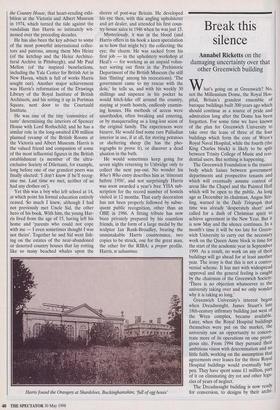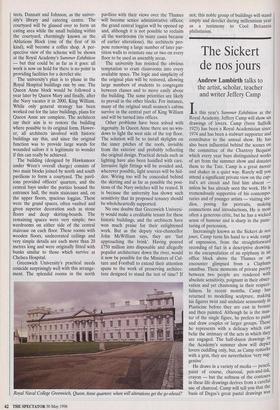Break this silence
Annabel Ricketts on the damaging uncertainty over that other Greenwich building What's going on at Greenwich? No, not the Millennium Dome, the Royal Hos- pital, Britain's grandest ensemble of baroque buildings built 300 years ago which should continue as a source of pride and admiration long after the Dome has been forgotten. For some time we have known of the plan for Greenwich University to take over the lease of three of the four buildings which form the core of Wren's Royal Naval Hospital, while the fourth (the King Charles block) is likely to be split between Trinity College of Music and resi- dential users. But nothing is happening.
The Greenwich Foundation is the trustee body which liaises between government departments and prospective tenants and which will eventually assume control of areas like the Chapel and the Painted Hall which will be open to the public. As long ago as December its chairman, Angus Stir- ling, warned in the Daily Telegraph that time was already 'desperately short' and called for a dash of Christmas spirit to achieve agreement in the New Year. But it is now May and the silence continues. In a month's time it will be too late for Green- wich University to carry out the necessary work on the Queen Anne block in time for the start of the academic year in September 1999. As a result, no work on any of their buildings will go ahead for at least another year. The irony is that this is not a contro- versial scheme. It has met with widespread approval and the general feeling is caught by the chairman of the Greenwich Society: `There is no objection whatsoever to the university taking over and we only wonder why it is taking so long.'
Greenwich University's interest began when Dreadnought, James Stuart's late 18th-century infirmary building just west of the Wren complex, became available. Later, when the Royal Hospital buildings themselves were put on the market, the university saw an opportunity to concen- trate more of its operations on one presti- gious site. From 1994 they pursued their ambitious vision with determination and no little faith, working on the assumption that agreements over leases for the three Royal Hospital buildings would eventually hap- pen. They have spent some £1 million, part of it on eliminating dry rot and other lega- cies of years of neglect. The Dreadnought building is now ready for conversion, to designs by their archi- tects, Dannatt and Johnson, as the univer- sity's library and catering centre. The courtyard will be glassed over to form an eating area while the small building within the courtyard, charmingly known as the Ablutions Block (one of the first of its kind), will become a coffee shop. A per- spective view of the scheme will be shown at the Royal Academy's Summer Exhibition — but that could be as far as it goes: all work is now on hold for there is no point in providing facilities for a derelict site.
The university's plan is to phase in the Royal Hospital buildings one by one. The Queen Anne block would be followed a year later by Queen Mary and finally, after the Navy vacates it in 2000, King William. While only general strategy has been worked out for the later buildings, plans for Queen Anne are complete. The architects say their aim is to restore the building where possible to its original form. Howev- er, all architects involved with historic buildings say this, and since the original function was to provide large wards for wounded sailors it is legitimate to wonder if this can really be achieved.
The building (designed by Hawksmoor under Wren's overall charge) consists of two main blocks joined by north and south pavilions to form a courtyard. The pavil- ions provided officers' quarters, and the central bays under the portico housed the entrance hall, the main staircases and, on the upper floors, spacious loggias. These were the grand spaces, often vaulted and given superior decoration such as stone floors and deep skirting-boards. The remaining spaces were very simple; two wardrooms on either side of the central staircase on each floor. These rooms with wooden floors, undecorated ceilings and very simple details are each more than 20 metres long and were originally fitted with bunks similar to those which survive at Chelsea Hospital.
Greenwich University's practical needs coincide surprisingly well with this arrange- ment. The splendid rooms in the north pavilion with their views over the Thames will become senior administrative offices; the grand central loggias will be opened up and, although it is not possible to reclaim all the wardrooms (in many cases because of earlier alterations), the architects pro- pose removing a large number of later par- tition walls to reinstate one or two on every floor to be used as assembly areas.
The university has resisted the obvious temptation to cram classrooms into every available space. The logic and simplicity of the original plan will be restored, allowing large numbers of students to congregate between classes and to move easily about the building. The same priorities are likely to prevail in the other blocks. For instance, many of the original small seamen's cabins survive in the central part of King William and will be turned into offices.
Other problems have been solved with ingenuity. In Queen Anne there are no win- dows to light the west side of the top floor. The solution will be to install skylights on the inner pitches of the roofs, invisible from the exterior and probably reflecting the original design. Practical details such as lighting have also been handled with care. Intrusive light fittings will be avoided and, wherever possible, light sources will be hid- den. Wiring too will be concealed behind the skirting and as far as possible the posi- tions of the Navy switches will be reused. It is because the university has shown such sensitivity that its proposed tenancy should be wholeheartedly supported.
No one doubts that Greenwich Universi- ty would make a creditable tenant for these historic buildings, and the architects have won much praise for their enlightened work. But as the deputy vice-chancellor John Mc William says, they are 'fast approaching the brink'. Having poured £750 million into disposable and allegedly populist architecture down the river, would it now be possible for the Ministers of Cul- ture and Football to extend their attention spans to the work of preserving architec- ture designed to stand the test of time? If Royal Naval College Greenwich, Queen Anne quarters: when will alterations get the go-ahead? not, this noble group of buildings will stand empty and derelict during millennium year as a testimony to Cool Britannia philistinism.



































































 Previous page
Previous page